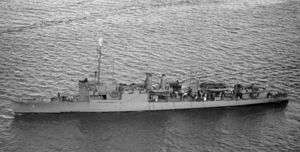USS Childs (DD-241)
 USS Childs in 1944 as seaplane tender AVD-1 | |
| History | |
|---|---|
| Namesake: | Earle W. F. Childs |
| Builder: | New York Shipbuilding |
| Laid down: | 19 March 1919 |
| Launched: | 15 September 1920 |
| Commissioned: | 22 October 1920 |
| Decommissioned: | 10 December 1945 |
| Struck: | 3 January 1946 |
| Fate: | sold 3 January 1946 |
| General characteristics | |
| Class & type: | Clemson-class destroyer |
| Displacement: | 1,215 tons |
| Length: | 314 feet 4 inches (95.81 m) |
| Beam: | 31 feet 8 inches (9.65 m) |
| Draft: | 9 feet 10 inches (3 m) |
| Propulsion: |
|
| Speed: | 35 knots (65 km/h) |
| Range: | |
| Complement: | 137 officers and enlisted |
| Armament: | 4 x 4" (102 mm), 1 x 3" (76 mm), 12 x 21" (533 mm) tt. |
USS Childs (DD-241/AVP-14/AVD-1) was a Clemson-class destroyer in the United States Navy during World War II. She was named for Earle W. F. Childs.
History
Childs (DD-241) was launched 15 September 1920 by New York Shipbuilding Corporation; sponsored by Mrs. E. W. F. Childs; and commissioned 22 October 1920, Commander I. H. Mayfield in command.
Arriving at Gibraltar 14 February 1921, Childs joined U.S. Naval Forces, Europe, to cruise in the Mediterranean, Adriatic, North, and Baltic Seas until 25 November, when she arrived at Constantinople. Here she joined the relief mission sent to Russia early in 1922, remaining in the Black Sea on diplomatic duties until 1 April. On 8 July, she departed from Cherbourg for Philadelphia, returning to the United States 29 July.
Childs conducted training operations, and joined other ships in fleet exercises along the Atlantic coast and in the Caribbean until 14 February 1925, when with the Scouting Fleet she stood out of Guantanamo Bay for large scale fleet exercises in the Hawaiian Islands and then returned to the east coast. In 1932, 1933, and 1934, the annual concentration of the Fleet for battle practice was again held on the West Coast, and Childs took part. With her home port changed to San Diego, California 9 November Childs served as flagship of Destroyer Division 8 Rotating Reserve, Scouting Force, 5 January-15 June when she was in full commission again. She spent the summer of 1935 cruising off the Pacific Northwest and Alaska.
The next year Childs returned to the east coast for overhaul, then returned to duty at San Diego, cruising several times to the Hawaiian Islands before 14 May 1938, when she cleared for Philadelphia and conversion to a seaplane tender. Reclassified AVP-14, she saw her first service in her new role during the annual fleet problem of 1939, operating between the Florida coast and San Juan, Puerto Rico, and after final preparations at Philadelphia, sailed for her new base at Pearl Harbor, arriving 29 June. She tended seaplanes there and on the plane guard stations off Midway, Wake Island, and Guam until 1 October 1940, when she was reclassified AVD-1, and ordered to the Asiatic Station. The next day she left Hawaii for Cavite, Philippines, arriving 1 November to begin her service to air patrol squadrons.
World War II
.jpg)
When war with Japan broke out, Childs lay in Cavite Navy Yard for repair, and during the devastation of the yard by Japanese aircraft on 10 December 1941, escaped damage by evasive maneuvering in the confined harbor area. She tended her flying boats of Patrol Wing 10 from Manila[1] for 4 more days, then began a lengthy base-to-base withdrawal. On leaving Kendari harbour on 24 January 1942 she evaded the invading Japanese fleet in a rain squall and survived an air attack.[2] At Surabaya the tenders Childs, Heron, and Preston rotated as needed to service VP101 which was patrolling Makassar Strait. Finally she reached Exmouth Gulf, Australia, 28 February 1942.[1] From Fremantle and other Western Australia ports, Childs continued her tender duties until 12 August 1944. During this time, her planes scouted and bombed Japanese positions and shipping, mined the waters off Balikpapan, Borneo, and performed air-sea rescue missions.
Childs returned to the west coast 19 September 1944, and after overhaul, conducted training operations off the west coast until the close of the war. She was decommissioned 10 December 1945, and sold 3 January 1946.
Childs received one battle star for World War II service.
References
- 1 2 Alsleben, Allan (1999–2000). "US Patrol Wing 10 in the Dutch East Indies, 1942". Forgotten Campaign: The Dutch East Indies Campaign 1941-1942.
- ↑ L, Klemen (1999–2000). "The Fall of Kendari, January 1942". Forgotten Campaign: The Dutch East Indies Campaign 1941-1942.
External links
- http://www.navsource.org/archives/05/241.htm
- This article incorporates text from the public domain Dictionary of American Naval Fighting Ships. The entry can be found here.